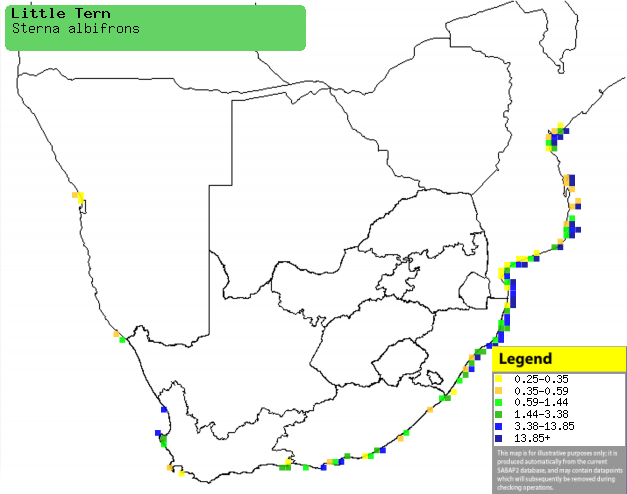|
Sterna albifrons (Little
tern)
Kleinsterretjie [Afrikaans]; Dwergstern [Dutch]; Sterne
naine [French]; Zwergseeschwalbe [German]; Gaivina-pequena [Portuguese]
Life
> Eukaryotes >
Opisthokonta
> Metazoa (animals) >
Bilateria >
Deuterostomia > Chordata >
Craniata > Vertebrata (vertebrates) > Gnathostomata (jawed
vertebrates) > Teleostomi (teleost fish) > Osteichthyes (bony fish) > Class:
Sarcopterygii (lobe-finned
fish) > Stegocephalia (terrestrial
vertebrates) > Tetrapoda
(four-legged vertebrates) > Reptiliomorpha > Amniota >
Reptilia (reptiles) >
Romeriida > Diapsida > Archosauromorpha > Archosauria >
Dinosauria
(dinosaurs) > Saurischia > Theropoda (bipedal predatory dinosaurs) >
Coelurosauria > Maniraptora > Aves
(birds) > Order: Charadriiformes
> Family: Laridae > Genus: Sterna
Distribution and habitat
Breeds in Europe, southern and eastern Asia, northern and
western Africa, Australia, Tasmania and New Guinea, heading south in the
non-breeding season to the Atlantic seaboard through the tropical Indian Ocean
to the West Pacific. It is locally fairly common in southern Africa, occurring
along the coast of Mozambique and South Africa, although scarce along the west
coast, generally preferring estuaries, coastal lagoons and salt pans.
|
 |
|
Distribution of Little tern in southern Africa,
based on statistical smoothing of the records from first SA Bird Atlas
Project (©
Animal Demography unit, University of
Cape Town; smoothing by Birgit Erni and Francesca Little). Colours range
from dark blue (most common) through to yellow (least common).
See here for the latest distribution
from the SABAP2. |
Movements and migrations
It starts to arrive in southern Africa in
August, with numbers peaking from December-February before it
departs in April and May.
Food
Mainly eats small fish, crustaceans and insects, doing most
of its foraging by flying upwind, 5-8 metres above water, searching for prey
which it plucks from the air or water.
Threats
Not threatened, although its European breeding colonies
have halved in size recently, mostly due to development and disturbance.
References
-
Hockey PAR, Dean WRJ and Ryan PG 2005. Roberts
- Birds of southern Africa, VIIth ed. The Trustees of the John Voelcker
Bird Book Fund, Cape Town.
|
